Related Research Articles

The kidney bean is a variety of the common bean named for its resemblance to a human kidney.
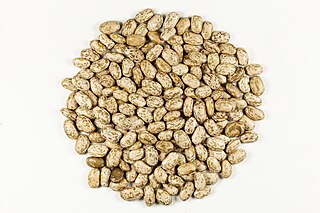
The pinto bean is a variety of common bean. In Spanish they are called frijoles pintos. It is the most popular bean by crop production in Northern Mexico and the Southwestern United States, and is most often eaten whole, or mashed and then refried. Prepared either way, it is a common filling for burritos, tostadas, or tacos in Mexican cuisine, also as a side or as part of an entrée served with a side tortilla or sopaipilla in New Mexican cuisine.

Spaghetti squash or vegetable spaghetti is a group of cultivars of Cucurbita pepo subsp. pepo. They are available in a variety of shapes, sizes, and colours, including ivory, yellow and orange, with orange having the highest amount of carotene. Its center contains many large seeds. When raw, the flesh is solid and similar to other raw squash. When cooked, the meat of the fruit falls away from the flesh in ribbons or strands that look like and can be used as an alternative to spaghetti.
Shoepeg corn is a cultivar of white sweetcorn valued for its sweetness. It is characterized by small, narrow kernels tightly and unevenly packed on the cob. The corn has a sweet, mild flavor. The most common variety of shoepeg corn available today is Country Gentleman.

A lima bean, also commonly known as butter bean, sieva bean, double bean or Madagascar bean, is a legume grown for its edible seeds or beans.

Phaseolus vulgaris, the common bean, is a herbaceous annual plant grown worldwide for its edible dry seeds or green, unripe pods. Its leaf is also occasionally used as a vegetable and the straw as fodder. Its botanical classification, along with other Phaseolus species, is as a member of the legume family, Fabaceae. Like most members of this family, common beans acquire the nitrogen they require through an association with rhizobia, which are nitrogen-fixing bacteria.

Chard or Swiss chard is a green leafy vegetable. In the cultivars of the Flavescens Group, the leaf stalks are large and often prepared separately from the leaf blade; the Cicla Group is the leafy spinach beet. The leaf blade can be green or reddish; the leaf stalks are usually white, yellow or red.

Green beans are young, unripe fruits of various cultivars of the common bean, although immature or young pods of the runner bean, yardlong bean, and hyacinth bean are used in a similar way. Green beans are known by many common names, including French beans, string beans, and snap beans or simply "snaps." In the Philippines, they are also known as "Baguio beans" or "habichuelas" to distinguish them from yardlong beans.

The black turtle bean is a small, shiny variety of the common bean especially popular in Latin American cuisine, though it can also be found in the Cajun and Creole cuisines of south Louisiana. Like all varieties of the common bean, it is native to the Americas, but has been introduced around the world. It is also used in Indian cuisine, Tamil cuisine, where it is known as karuppu kaaramani and in Maharashtrian cuisine, where it is known as kala ghevada. It is widely used in Uttrakhand, where it is also known as "bhatt". It is a rich source of iron and protein. The black turtle bean is often simply called the black bean, although this terminology can cause confusion with at least three other types of black beans.
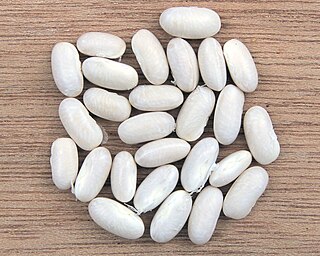
The navy bean, haricot bean, pearl haricot bean, Boston bean, white pea bean, or pea bean is a variety of the common bean native to the Americas, where it was first domesticated. It is a dry white bean that is smaller than many other types of white beans, and has an oval, slightly flattened shape. It features in such dishes as baked beans, various soups such as Senate bean soup, and bean pies.
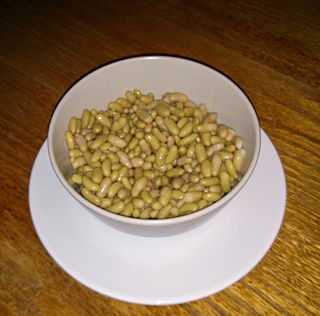
The flageolet bean is a variety of the common bean originating from France. The flageolet is picked before full maturity and dried in the shade to retain its green color. The bean is small, light green, and kidney-shaped. The texture is firm and creamy when shelled and cooked. The flageolet bean is grown in California.

The Beurré Bosc or Bosc is a cultivar of the European pear, originally from France or Belgium. Also known as the Kaiser, it is grown in Europe, Australia, British Columbia and Ontario, Canada, and the U.S. states of California, Washington, and Oregon.
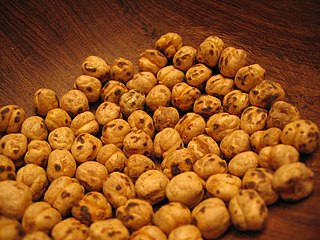
Leblebi is a snack made from roasted chickpeas, common and popular in Iran, Palestine, Jordan, Syria, Lebanon, Iraq, Greece, Turkey and Bulgaria and sometimes seasoned with salt, hot spices, dried cloves, or candy coated. In Aromanian it is known as nibilbé. In Tunisia, the term refers to a very popular chickpea-based breakfast soup which also includes egg and stale bread.
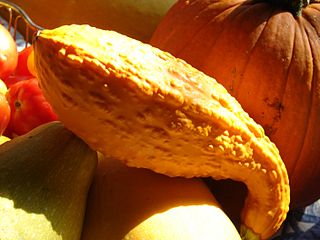
Crookneck squash, also known as yellow squash, is a cultivar of Cucurbita pepo, the species that also includes some pumpkins and most other summer squashes. The plants are bushy and do not spread like the plants of winter squash and pumpkin. Most often used as a summer squash, it is characterized by its yellow skin and sweet yellow flesh, as well as its distinctive curved stem-end or "crooked neck". It should not be confused with crookneck cultivars of Cucurbita moschata, such as the winter squash 'Golden Cushaw', or the vining summer squash 'Tromboncino'. Its name distinguishes it from another similar-looking variety of C. pepo, the straightneck squash, which is also usually yellow. There is one similar non-edible C. pepo variety: C. pepo var. ovifera.
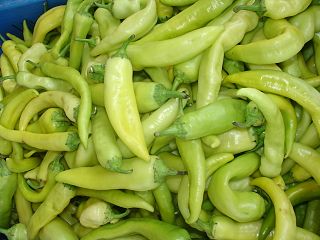
The banana pepper is an average-sized member of the chili pepper family that has a mild, tangy taste. While typically bright yellow, it is possible for them to change to green, red, or orange as they ripen. It is often pickled, stuffed or used as a raw ingredient in foods. It is a cultivar of the species Capsicum annuum. Its flavor is not very hot and, as is the case with most peppers, its heat depends on the maturity of the pepper, with the ripest being sweeter than younger ones.

The cranberry bean is a variety of common bean first bred in Colombia as the cargamanto. It is also known as the Borlotti bean, Roman bean, romano bean, saluggia bean, gadhra bean orrosecoco bean. The bean is a medium to large tan or hazelnut-colored bean splashed or streaked with red, magenta or black.

Red leaf lettuces are a group of lettuce cultivars with dark red or purple leaves. Red leaf lettuce cultivars include "Lollo Rossa", "New Red Fire Lettuce", "Red Sails Lettuce", "Redina Lettuce", "Henry's Leafy Friend", Galactic Lettuce", and the "Benito Lettuce".

The Calypso bean, pickle bean, orca bean, or yin yang bean, is a bean cultivar of the species Phaseolus vulgaris.

Dragon tongue bean, or dragon tongue shelling bean, is young green bean of cranberry bean, pinto bean in the species Phaseolus vulgaris.

The Habanaga is a cultivar of the chili pepper Capsicum chinense. This pepper was developed in New Mexico when a university student unintentionally crossed a Habanero and a Bhut Jolokia.
References
- ↑ United States Food and Drug Administration (2024). "Daily Value on the Nutrition and Supplement Facts Labels". FDA. Archived from the original on 2024-03-27. Retrieved 2024-03-28.
- ↑ National Academies of Sciences, Engineering, and Medicine; Health and Medicine Division; Food and Nutrition Board; Committee to Review the Dietary Reference Intakes for Sodium and Potassium (2019). "Chapter 4: Potassium: Dietary Reference Intakes for Adequacy". In Oria, Maria; Harrison, Meghan; Stallings, Virginia A. (eds.). Dietary Reference Intakes for Sodium and Potassium. The National Academies Collection: Reports funded by National Institutes of Health. Washington, DC: National Academies Press (US). pp. 120–121. doi:10.17226/25353. ISBN 978-0-309-48834-1. PMID 30844154 . Retrieved 2024-12-05.
- ↑ "Appaloosa Beans" . Retrieved 22 November 2014.
- ↑ "Appaloosa Beans (B02)". Archived from the original on 11 September 2016. Retrieved 22 November 2014.